brake fluid MITSUBISHI OUTLANDER PHEV 2014 Owner's Manual (in English)
[x] Cancel search | Manufacturer: MITSUBISHI, Model Year: 2014, Model line: OUTLANDER PHEV, Model: MITSUBISHI OUTLANDER PHEV 2014Pages: 442, PDF Size: 19.04 MB
Page 158 of 442
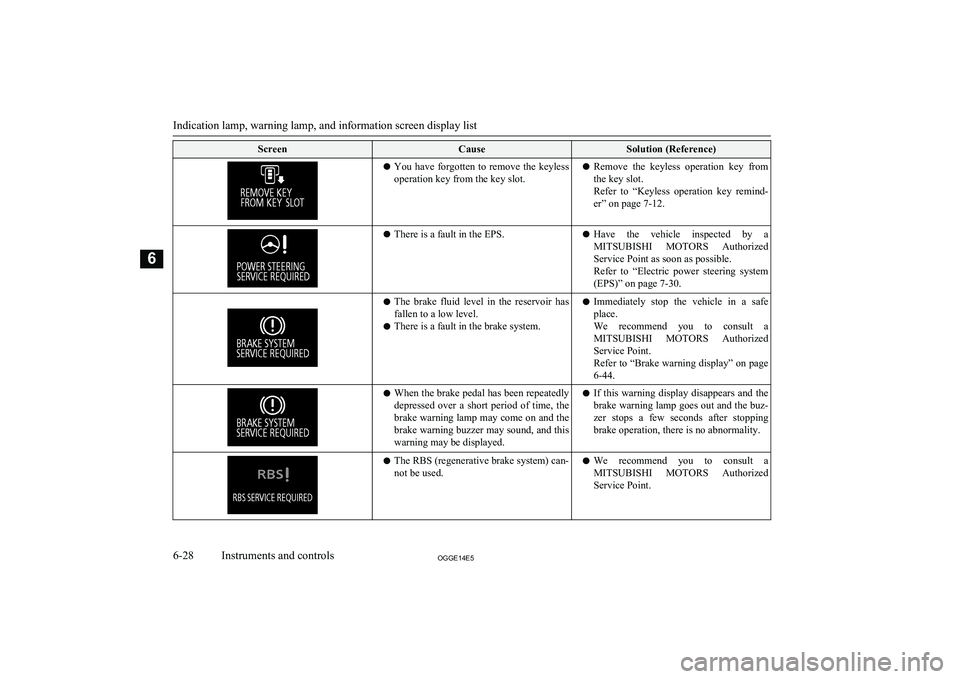
ScreenCauseSolution (Reference)lYou have forgotten to remove the keyless
operation key from the key slot.l Remove the keyless operation key from
the key slot.
Refer to “Keyless operation key remind-
er” on page 7-12.l There is a fault in the EPS.l Have the vehicle inspected by a
MITSUBISHI MOTORS Authorized
Service Point as soon as possible.
Refer to “Electric power steering system
(EPS)” on page 7-30.l The brake fluid level in the reservoir has
fallen to a low level.
l There is a fault in the brake system.lImmediately stop the vehicle in a safe
place.
We recommend you to consult a MITSUBISHI MOTORS Authorized
Service Point.
Refer to “Brake warning display” on page 6-44.l When the brake pedal has been repeatedly
depressed over a short period of time, the
brake warning lamp may come on and the brake warning buzzer may sound, and this warning may be displayed.l If this warning display disappears and the
brake warning lamp goes out and the buz-
zer stops a few seconds after stopping brake operation, there is no abnormality.l The RBS (regenerative brake system) can-
not be used.l We recommend you to consult a
MITSUBISHI MOTORS Authorized
Service Point.
Indication lamp, warning lamp, and information screen display list
6-28OGGE14E5Instruments and controls6
Page 172 of 442
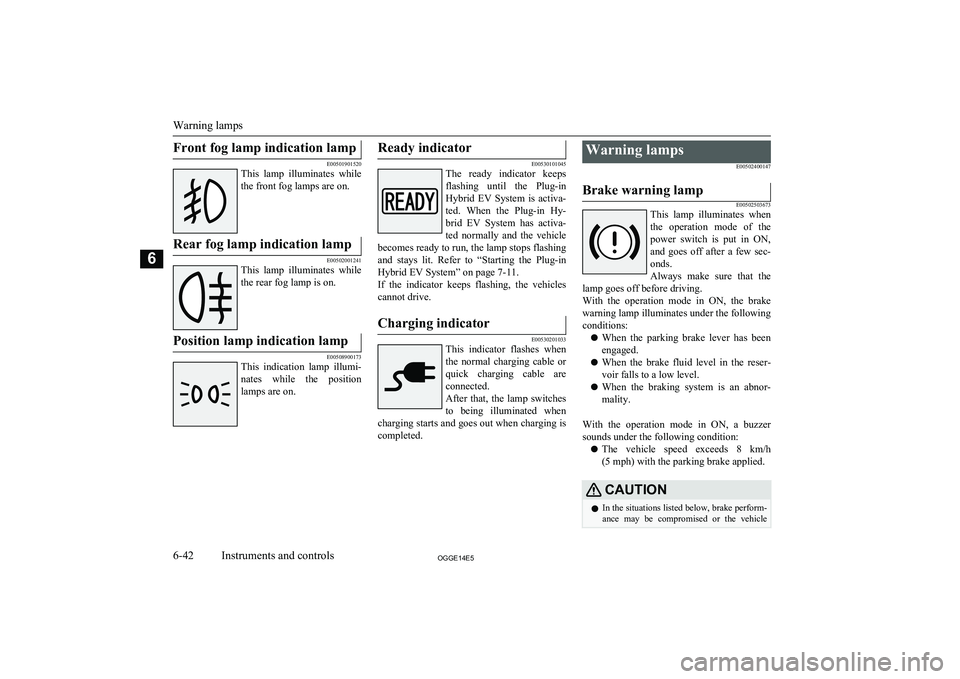
Front fog lamp indication lamp
E00501901520
This lamp illuminates while
the front fog lamps are on.
Rear fog lamp indication lamp
E00502001241
This lamp illuminates whilethe rear fog lamp is on.
Position lamp indication lamp
E00508900173
This indication lamp illumi-
nates while the position lamps are on.
Ready indicator
E00530101045
The ready indicator keeps
flashing until the Plug-in
Hybrid EV System is activa- ted. When the Plug-in Hy-
brid EV System has activa- ted normally and the vehicle
becomes ready to run, the lamp stops flashing
and stays lit. Refer to “Starting the Plug-in
Hybrid EV System” on page 7-11.
If the indicator keeps flashing, the vehicles cannot drive.
Charging indicator
E00530201033
This indicator flashes when the normal charging cable or
quick charging cable are connected.
After that, the lamp switches to being illuminated when
charging starts and goes out when charging is
completed.
Warning lamps
E00502400147Brake warning lamp
E00502503673
This lamp illuminates whenthe operation mode of thepower switch is put in ON,
and goes off after a few sec- onds.
Always make sure that the
lamp goes off before driving.
With the operation mode in ON, the brake
warning lamp illuminates under the following conditions:
l When the parking brake lever has been
engaged.
l When the brake fluid level in the reser-
voir falls to a low level.
l When the braking system is an abnor-
mality.
With the operation mode in ON, a buzzer sounds under the following condition:
l The vehicle speed exceeds 8 km/h
(5 mph) with the parking brake applied.
CAUTIONl In the situations listed below, brake perform-
ance may be compromised or the vehicle
Warning lamps
6-42OGGE14E5Instruments and controls6
Page 175 of 442
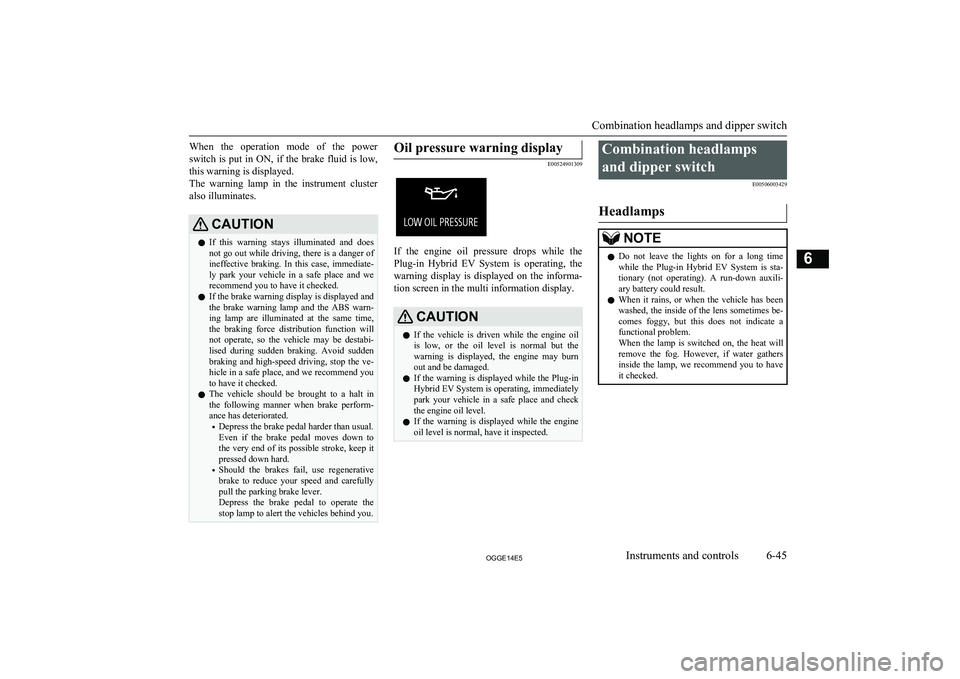
When the operation mode of the power
switch is put in ON, if the brake fluid is low,
this warning is displayed.
The warning lamp in the instrument cluster also illuminates.CAUTIONl If this warning stays illuminated and does
not go out while driving, there is a danger of ineffective braking. In this case, immediate-
ly park your vehicle in a safe place and we recommend you to have it checked.
l If the brake warning display is displayed and
the brake warning lamp and the ABS warn- ing lamp are illuminated at the same time,
the braking force distribution function will
not operate, so the vehicle may be destabi- lised during sudden braking. Avoid sudden
braking and high-speed driving, stop the ve-
hicle in a safe place, and we recommend you to have it checked.
l The vehicle should be brought to a halt in
the following manner when brake perform-
ance has deteriorated.
• Depress the brake pedal harder than usual.
Even if the brake pedal moves down to
the very end of its possible stroke, keep it pressed down hard.
• Should the brakes fail, use regenerative
brake to reduce your speed and carefully
pull the parking brake lever.
Depress the brake pedal to operate the
stop lamp to alert the vehicles behind you.Oil pressure warning display
E00524901309
If the engine oil pressure drops while the
Plug-in Hybrid EV System is operating, thewarning display is displayed on the informa-
tion screen in the multi information display.
CAUTIONl If the vehicle is driven while the engine oil
is low, or the oil level is normal but the warning is displayed, the engine may burn
out and be damaged.
l If the warning is displayed while the Plug-in
Hybrid EV System is operating, immediately
park your vehicle in a safe place and check
the engine oil level.
l If the warning is displayed while the engine
oil level is normal, have it inspected.Combination headlamps
and dipper switch E00506003429
HeadlampsNOTEl Do not leave the lights on for a long time
while the Plug-in Hybrid EV System is sta-tionary (not operating). A run-down auxili- ary battery could result.
l When it rains, or when the vehicle has been
washed, the inside of the lens sometimes be-
comes foggy, but this does not indicate a
functional problem.
When the lamp is switched on, the heat will remove the fog. However, if water gathers
inside the lamp, we recommend you to have it checked.
Combination headlamps and dipper switch
6-45OGGE14E5Instruments and controls6
Page 245 of 442
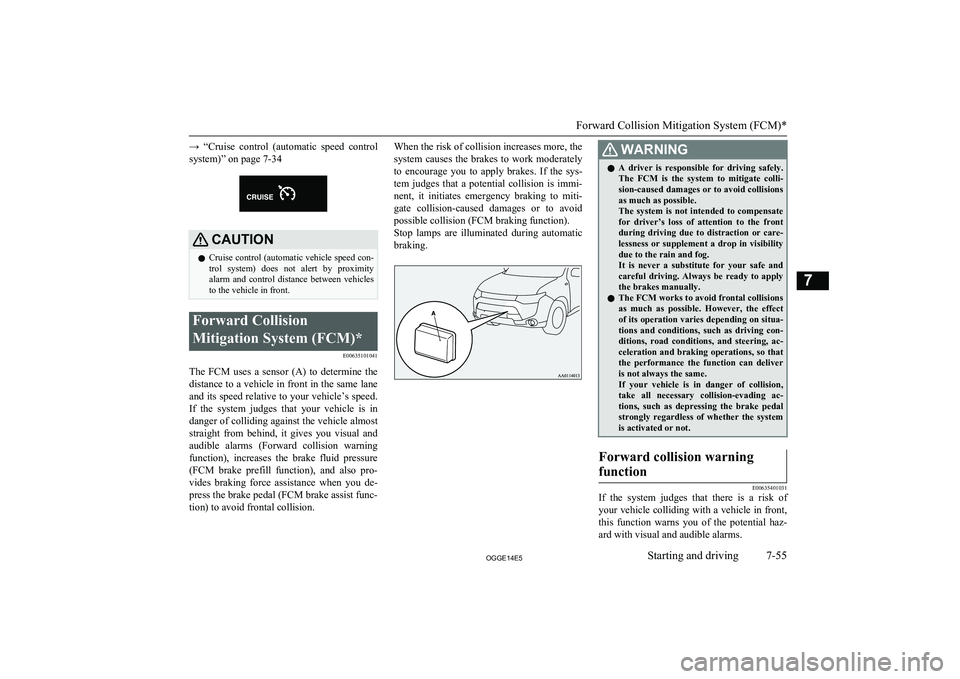
→ “Cruise control (automatic speed controlsystem)” on page 7-34CAUTIONl Cruise control (automatic vehicle speed con-
trol system) does not alert by proximity
alarm and control distance between vehicles to the vehicle in front.Forward Collision
Mitigation System (FCM)* E00635101041
The FCM uses a sensor (A) to determine thedistance to a vehicle in front in the same laneand its speed relative to your vehicle’s speed. If the system judges that your vehicle is in
danger of colliding against the vehicle almost
straight from behind, it gives you visual and
audible alarms (Forward collision warning function), increases the brake fluid pressure
(FCM brake prefill function), and also pro- vides braking force assistance when you de-press the brake pedal (FCM brake assist func-
tion) to avoid frontal collision.
When the risk of collision increases more, the
system causes the brakes to work moderately to encourage you to apply brakes. If the sys-tem judges that a potential collision is immi-
nent, it initiates emergency braking to miti- gate collision-caused damages or to avoidpossible collision (FCM braking function).Stop lamps are illuminated during automatic
braking.WARNINGl A driver is responsible for driving safely.
The FCM is the system to mitigate colli-sion-caused damages or to avoid collisionsas much as possible.
The system is not intended to compensate
for driver’s loss of attention to the front during driving due to distraction or care-
lessness or supplement a drop in visibility
due to the rain and fog.
It is never a substitute for your safe and careful driving. Always be ready to applythe brakes manually.
l The FCM works to avoid frontal collisions
as much as possible. However, the effect of its operation varies depending on situa-
tions and conditions, such as driving con- ditions, road conditions, and steering, ac-
celeration and braking operations, so that
the performance the function can deliver
is not always the same.
If your vehicle is in danger of collision,
take all necessary collision-evading ac- tions, such as depressing the brake pedal strongly regardless of whether the systemis activated or not.Forward collision warning
function
E00635401031
If the system judges that there is a risk of your vehicle colliding with a vehicle in front,
this function warns you of the potential haz-
ard with visual and audible alarms.
Forward Collision Mitigation System (FCM)*
7-55OGGE14E5Starting and driving7
Page 246 of 442
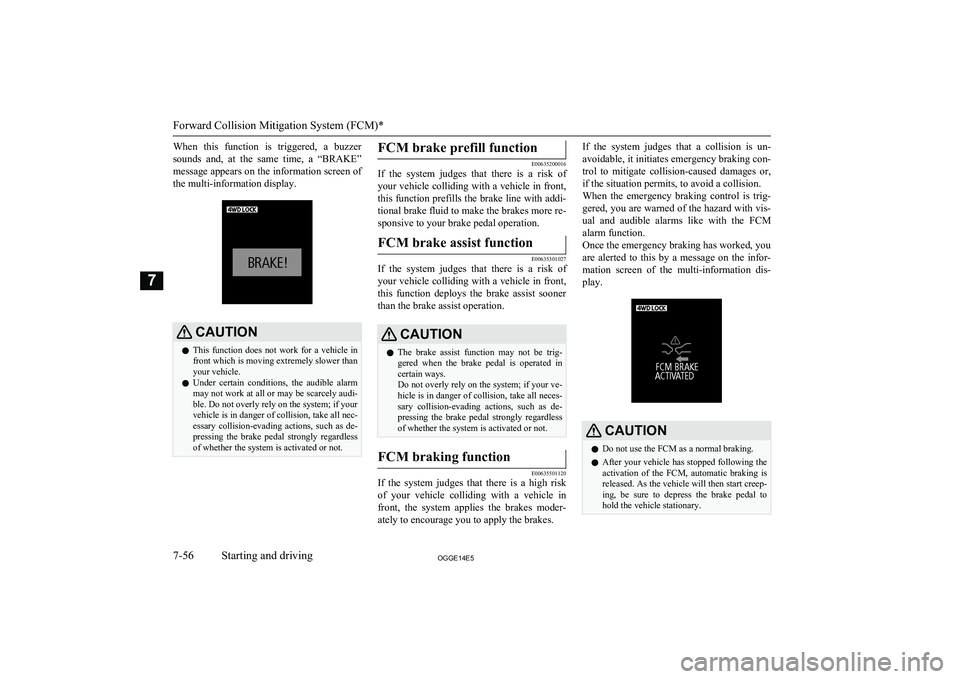
When this function is triggered, a buzzer
sounds and, at the same time, a “BRAKE” message appears on the information screen of
the multi-information display.CAUTIONl This function does not work for a vehicle in
front which is moving extremely slower than
your vehicle.
l Under certain conditions, the audible alarm
may not work at all or may be scarcely audi-
ble. Do not overly rely on the system; if your
vehicle is in danger of collision, take all nec- essary collision-evading actions, such as de-
pressing the brake pedal strongly regardless of whether the system is activated or not.FCM brake prefill function
E00635200016
If the system judges that there is a risk of
your vehicle colliding with a vehicle in front,
this function prefills the brake line with addi- tional brake fluid to make the brakes more re-
sponsive to your brake pedal operation.
FCM brake assist function
E00635301027
If the system judges that there is a risk of your vehicle colliding with a vehicle in front,
this function deploys the brake assist sooner than the brake assist operation.
CAUTIONl The brake assist function may not be trig-
gered when the brake pedal is operated in certain ways.
Do not overly rely on the system; if your ve-
hicle is in danger of collision, take all neces-
sary collision-evading actions, such as de-
pressing the brake pedal strongly regardless of whether the system is activated or not.FCM braking function
E00635501120
If the system judges that there is a high risk
of your vehicle colliding with a vehicle in
front, the system applies the brakes moder-
ately to encourage you to apply the brakes.
If the system judges that a collision is un-
avoidable, it initiates emergency braking con-trol to mitigate collision-caused damages or,
if the situation permits, to avoid a collision.
When the emergency braking control is trig- gered, you are warned of the hazard with vis-
ual and audible alarms like with the FCM
alarm function.
Once the emergency braking has worked, you
are alerted to this by a message on the infor- mation screen of the multi-information dis- play.CAUTIONl Do not use the FCM as a normal braking.
l After your vehicle has stopped following the
activation of the FCM, automatic braking is
released. As the vehicle will then start creep-
ing, be sure to depress the brake pedal to
hold the vehicle stationary.
Forward Collision Mitigation System (FCM)*
7-56OGGE14E5Starting and driving7
Page 375 of 442
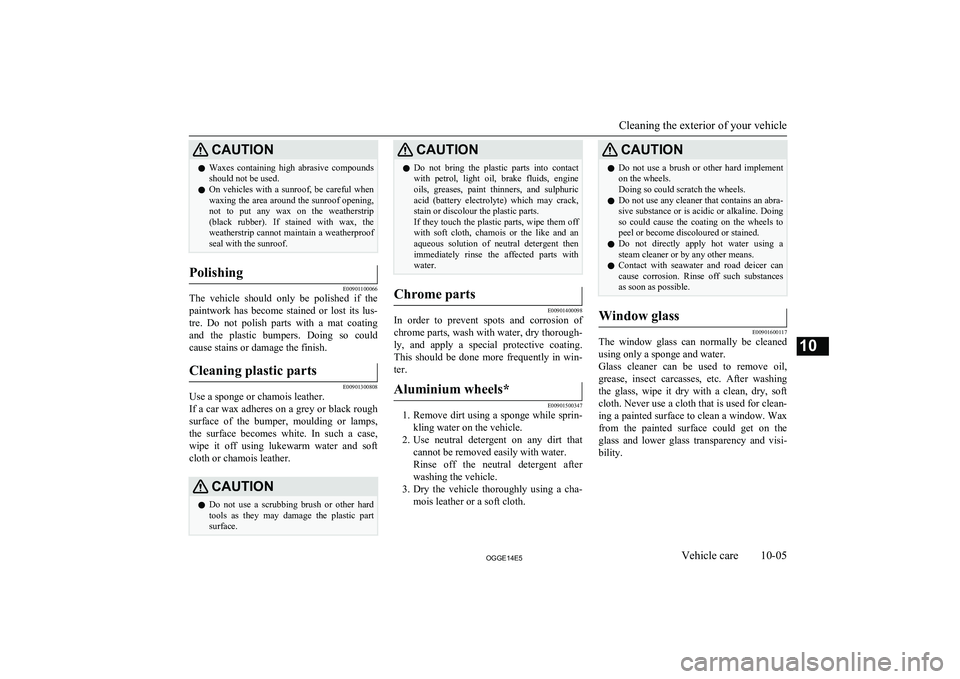
CAUTIONlWaxes containing high abrasive compounds
should not be used.
l On vehicles with a sunroof, be careful when
waxing the area around the sunroof opening, not to put any wax on the weatherstrip
(black rubber). If stained with wax, the
weatherstrip cannot maintain a weatherproof seal with the sunroof.Polishing
E00901100066
The vehicle should only be polished if the
paintwork has become stained or lost its lus- tre. Do not polish parts with a mat coating
and the plastic bumpers. Doing so could cause stains or damage the finish.
Cleaning plastic parts
E00901300808
Use a sponge or chamois leather.
If a car wax adheres on a grey or black rough surface of the bumper, moulding or lamps,
the surface becomes white. In such a case,
wipe it off using lukewarm water and soft cloth or chamois leather.
CAUTIONl Do not use a scrubbing brush or other hard
tools as they may damage the plastic part surface.CAUTIONl Do not bring the plastic parts into contact
with petrol, light oil, brake fluids, engine
oils, greases, paint thinners, and sulphuric acid (battery electrolyte) which may crack,stain or discolour the plastic parts.
If they touch the plastic parts, wipe them off
with soft cloth, chamois or the like and an aqueous solution of neutral detergent thenimmediately rinse the affected parts with
water.Chrome parts
E00901400098
In order to prevent spots and corrosion of
chrome parts, wash with water, dry thorough-
ly, and apply a special protective coating.
This should be done more frequently in win- ter.
Aluminium wheels*
E00901500347
1. Remove dirt using a sponge while sprin-
kling water on the vehicle.
2. Use neutral detergent on any dirt that
cannot be removed easily with water.
Rinse off the neutral detergent after
washing the vehicle.
3. Dry the vehicle thoroughly using a cha-
mois leather or a soft cloth.
CAUTIONl Do not use a brush or other hard implement
on the wheels.
Doing so could scratch the wheels.
l Do not use any cleaner that contains an abra-
sive substance or is acidic or alkaline. Doing
so could cause the coating on the wheels to peel or become discoloured or stained.
l Do not directly apply hot water using a
steam cleaner or by any other means.
l Contact with seawater and road deicer can
cause corrosion. Rinse off such substances as soon as possible.Window glass
E00901600117
The window glass can normally be cleaned
using only a sponge and water.
Glass cleaner can be used to remove oil, grease, insect carcasses, etc. After washing
the glass, wipe it dry with a clean, dry, soft cloth. Never use a cloth that is used for clean-ing a painted surface to clean a window. Waxfrom the painted surface could get on the
glass and lower glass transparency and visi-
bility.
Cleaning the exterior of your vehicle
10-05OGGE14E5Vehicle care10
Page 377 of 442
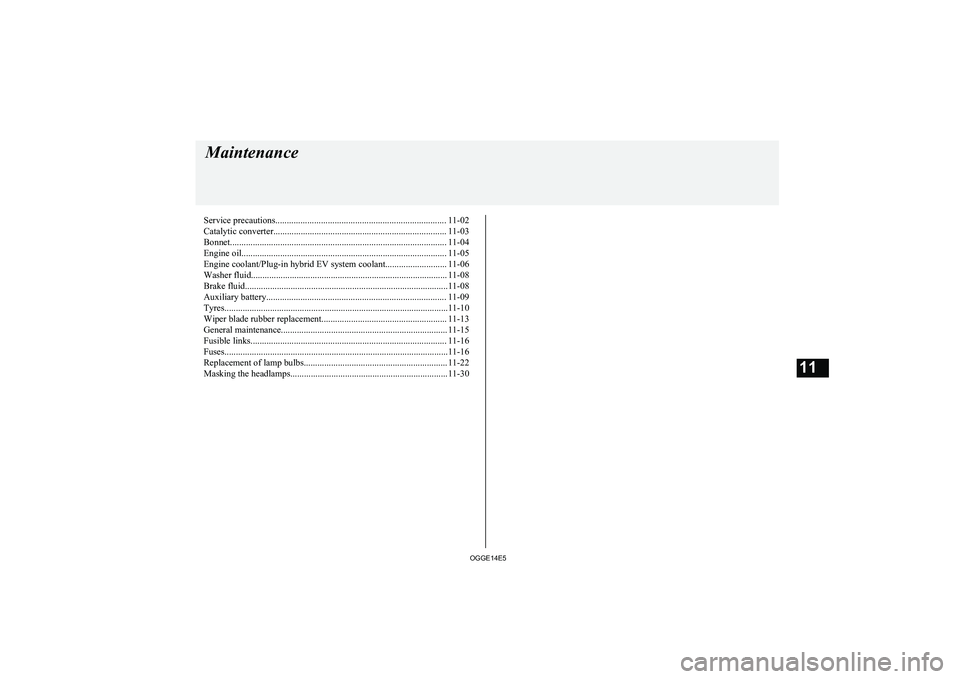
Service precautions........................................................................... 11-02
Catalytic converter............................................................................ 11-03
Bonnet............................................................................................... 11-04
Engine oil.......................................................................................... 11-05 Engine coolant/Plug-in hybrid EV system coolant........................... 11-06
Washer fluid...................................................................................... 11-08
Brake fluid.........................................................................................11-08
Auxiliary battery............................................................................... 11-09
Tyres..................................................................................................11-10 Wiper blade rubber replacement....................................................... 11-13
General maintenance......................................................................... 11-15
Fusible links...................................................................................... 11-16
Fuses..................................................................................................11-16
Replacement of lamp bulbs............................................................... 11-22
Masking the headlamps.....................................................................11-30Maintenance
OGGE14E511
Page 379 of 442
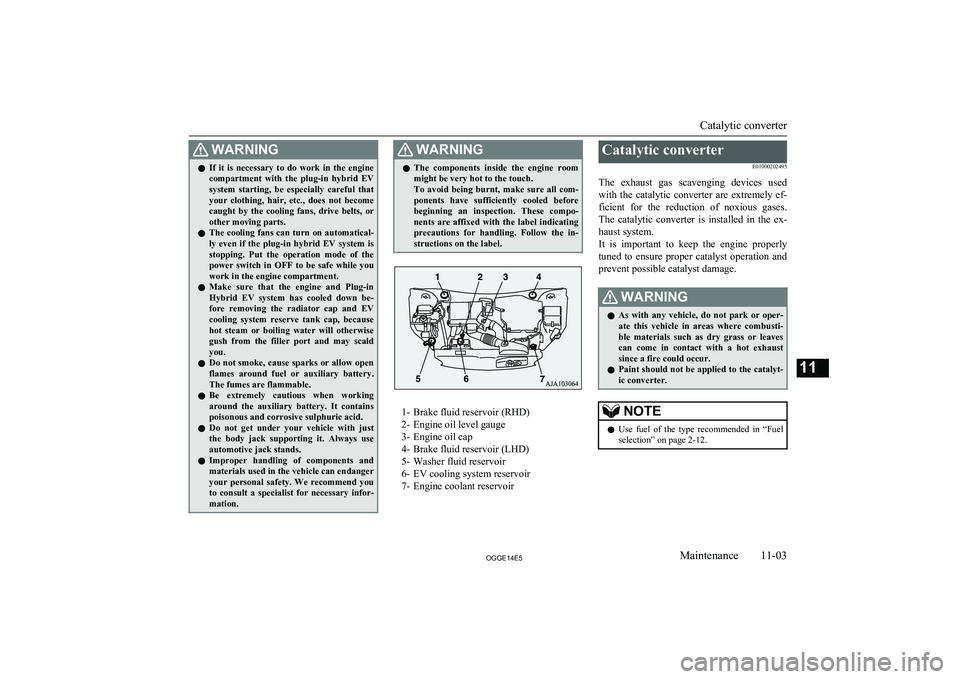
WARNINGlIf it is necessary to do work in the engine
compartment with the plug-in hybrid EV
system starting, be especially careful that
your clothing, hair, etc., does not become caught by the cooling fans, drive belts, orother moving parts.
l The cooling fans can turn on automatical-
ly even if the plug-in hybrid EV system is
stopping. Put the operation mode of the
power switch in OFF to be safe while you work in the engine compartment.
l Make sure that the engine and Plug-in
Hybrid EV system has cooled down be- fore removing the radiator cap and EV
cooling system reserve tank cap, because hot steam or boiling water will otherwise
gush from the filler port and may scald you.
l Do not smoke, cause sparks or allow open
flames around fuel or auxiliary battery.
The fumes are flammable.
l Be extremely cautious when working
around the auxiliary battery. It contains
poisonous and corrosive sulphuric acid.
l Do not get under your vehicle with just
the body jack supporting it. Always use automotive jack stands.
l Improper handling of components and
materials used in the vehicle can endangeryour personal safety. We recommend you to consult a specialist for necessary infor-
mation.WARNINGl The components inside the engine room
might be very hot to the touch.
To avoid being burnt, make sure all com- ponents have sufficiently cooled before beginning an inspection. These compo-
nents are affixed with the label indicating precautions for handling. Follow the in-structions on the label.
1- Brake fluid reservoir (RHD)
2- Engine oil level gauge
3- Engine oil cap
4- Brake fluid reservoir (LHD)
5- Washer fluid reservoir
6- EV cooling system reservoir
7- Engine coolant reservoir
Catalytic converter
E01000202495
The exhaust gas scavenging devices used with the catalytic converter are extremely ef- ficient for the reduction of noxious gases.
The catalytic converter is installed in the ex- haust system.
It is important to keep the engine properly
tuned to ensure proper catalyst operation and prevent possible catalyst damage.WARNINGl As with any vehicle, do not park or oper-
ate this vehicle in areas where combusti- ble materials such as dry grass or leaves
can come in contact with a hot exhaust
since a fire could occur.
l Paint should not be applied to the catalyt-
ic converter.NOTEl Use fuel of the type recommended in
“Fuel
selection” on page 2-12.
Catalytic converter
11-03OGGE14E5Maintenance11
Page 384 of 442
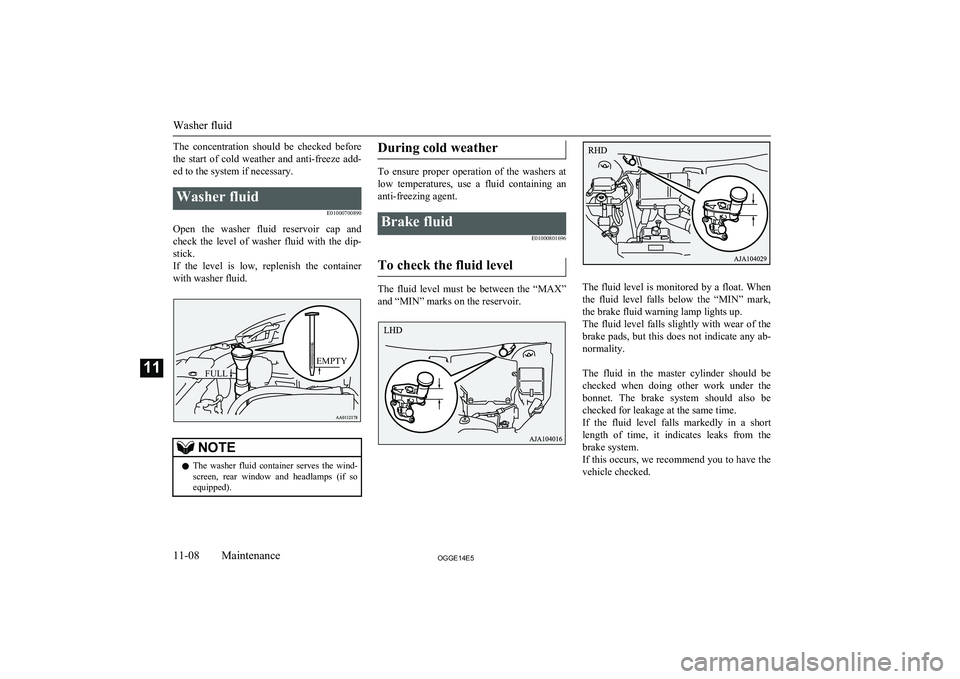
The concentration should be checked beforethe start of cold weather and anti-freeze add-
ed to the system if necessary.Washer fluid
E01000700890
Open the washer fluid reservoir cap andcheck the level of washer fluid with the dip- stick.
If the level is low, replenish the container with washer fluid.
NOTEl The washer fluid container serves the wind-
screen, rear window and headlamps (if soequipped).During cold weather
To ensure proper operation of the washers at
low temperatures, use a fluid containing ananti-freezing agent.
Brake fluid
E01000801696
To check the fluid level
The fluid level must be between the “MAX”
and “MIN” marks on the reservoir.The fluid level is monitored by a float. When
the fluid level falls below the “MIN” mark, the brake fluid warning lamp lights up.The fluid level falls slightly with wear of the brake pads, but this does not indicate any ab-
normality.
The fluid in the master cylinder should be checked when doing other work under thebonnet. The brake system should also be checked for leakage at the same time.
If the fluid level falls markedly in a short length of time, it indicates leaks from the
brake system.
If this occurs, we recommend you to have the
vehicle checked.
Washer fluid
11-08OGGE14E5Maintenance11FULLEMPTY
Page 385 of 442
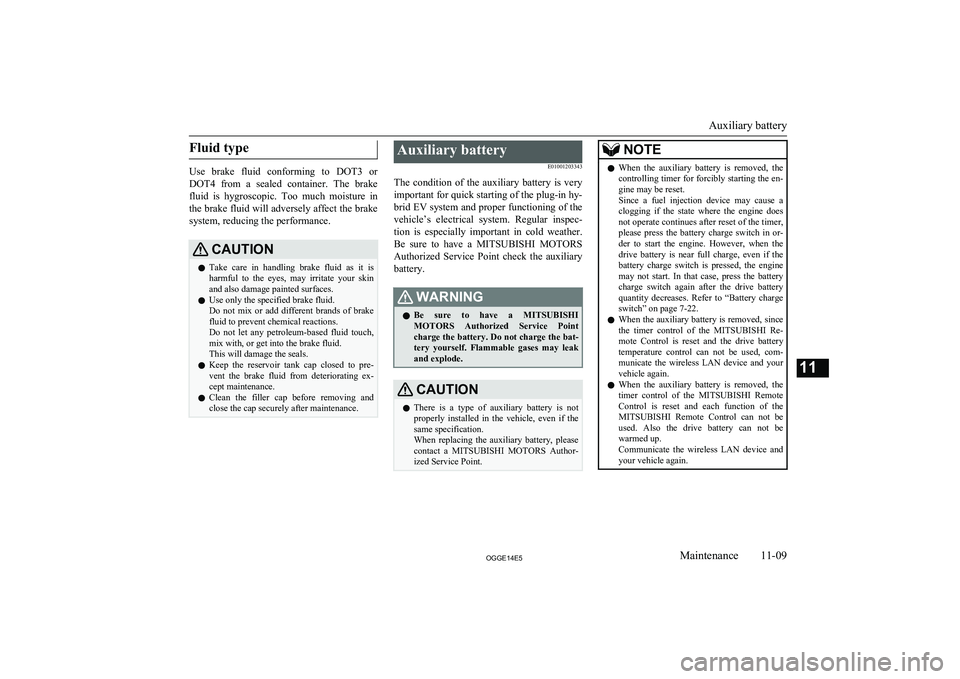
Fluid type
Use brake fluid conforming to DOT3 or
DOT4 from a sealed container. The brake fluid is hygroscopic. Too much moisture in
the brake fluid will adversely affect the brake system, reducing the performance.
CAUTIONl Take care in handling brake fluid as it is
harmful to the eyes, may irritate your skin
and also damage painted surfaces.
l Use only the specified brake fluid.
Do not mix or add different brands of brake fluid to prevent chemical reactions.
Do not let any petroleum-based fluid touch, mix with, or get into the brake fluid.
This will damage the seals.
l Keep the reservoir tank cap closed to pre-
vent the brake fluid from deteriorating ex- cept maintenance.
l Clean the filler cap before removing and
close the cap securely after maintenance.Auxiliary battery
E01001203343
The condition of the auxiliary battery is very
important for quick starting of the plug-in hy-
brid EV system and proper functioning of the vehicle’s electrical system. Regular inspec- tion is especially important in cold weather.
Be sure to have a MITSUBISHI MOTORS
Authorized Service Point check the auxiliary battery.WARNINGl Be sure to have a
MITSUBISHI
MOTORS Authorized Service Point
charge the battery. Do not charge the bat- tery yourself. Flammable gases may leak
and explode.CAUTIONl There is a type of auxiliary battery is not
properly installed in the vehicle, even if thesame specification.
When replacing the auxiliary battery, please
contact a MITSUBISHI MOTORS Author-
ized Service Point.NOTEl When the auxiliary battery is removed, the
controlling timer for forcibly starting the en-
gine may be reset.
Since a fuel injection device may cause a clogging if the state where the engine does
not operate continues after reset of the timer,
please press the battery charge switch in or-
der to start the engine. However, when the drive battery is near full charge, even if the
battery charge switch is pressed, the engine
may not start. In that case, press the battery charge switch again after the drive battery
quantity decreases. Refer to “Battery charge
switch” on page 7-22.
l When the auxiliary battery is removed, since
the timer control of the MITSUBISHI Re-
mote Control is reset and the drive battery
temperature control can not be used, com- municate the wireless LAN device and your
vehicle again.
l When the auxiliary battery is removed, the
timer control of the MITSUBISHI Remote
Control is reset and each function of the MITSUBISHI Remote Control can not be
used. Also the drive battery can not be
warmed up.
Communicate the wireless LAN device and your vehicle again.
Auxiliary battery
11-09OGGE14E5Maintenance11